This post is a curated collection of some of the famous Parrot paintings of Edward Lear. They are some of the most beautiful and colourful illustrations of parrots ever painted.
Edward Lear is probably more famous for his nonsense poem “The Owl and The Pussycat” He wrote the poem for the daughter of a friend, and poet John Symonds, in 1871.
He wasn’t just a poet. Edward Lear was one of the best ornithological artists of his era. At the start of his career, Lear’s primary source of income was as a bird illustrator. He worked for the Zoological Society of London.
Lear was one of the first ornithological painters to base his artwork on live birds rather than skins. The live parrots weren’t in the wild. He painted the parrots at London Zoo and others in private collections. When he was only 19, he published his first bird book, “Illustrations of the Family of Psittacidae, or Parrots.”
There are approximately 393 different species of Parrots, also knowns as Psittacines. Their habitat is the southern hemisphere in the subtropical regions. Most species of parrots are found in South America and Australasia.
Parrots have always had a widespread appeal, mainly for their beautiful colourful appearance and intelligence. They are well known for their ability to imitate the human voice.
Antique copyright-free Parrot Paintings of Edward Lear
This collection of parrot paintings are from the book “Illustrations of the Family of Psittacidae, or Parrots”

To download the vintage parrot illustrations click on the highlighted title link, and a higher-resolution jpg image will automatically open in a new tab in your browser. You can then print these images or save them to your hard drive.
If you want ideas on displaying these images, there is a great tutorial for an upcycled gallery wall. Also, you can make an incredible tropical parrot decor display in a glass dome/cloche.
The Vintage Parrot Paintings
1. Lesser Sulphur Crested Cockatoo
Yes, cockatoos are a species of parrot! This is my favourite, as it reminds me of my childhood. I grew up in Hong Kong, where we used to get these beautiful wild birds in our garden. Despite the fact, they are an endangered species.
Surprisingly, Hong Kong has become a sanctuary for Sulphur Crested cockatoos driven close to extinction from their original habitat. Amazingly, 10% of this species of cockatoo have made the bustling city of Hong Kong their home.
It was actually through looking for a print of a sulphur cockatoo to hang on my wall that I came across this fabulous collection of parrot paintings.

2. Lear’s Macaw
I know the parrot illustration says Hyacinth Macaw, but it is now widely believed that Lear’s identification was incorrect. This beautiful Indigo Brazilian parrot is now known as Lear’s Macaw (Anodorhynchus
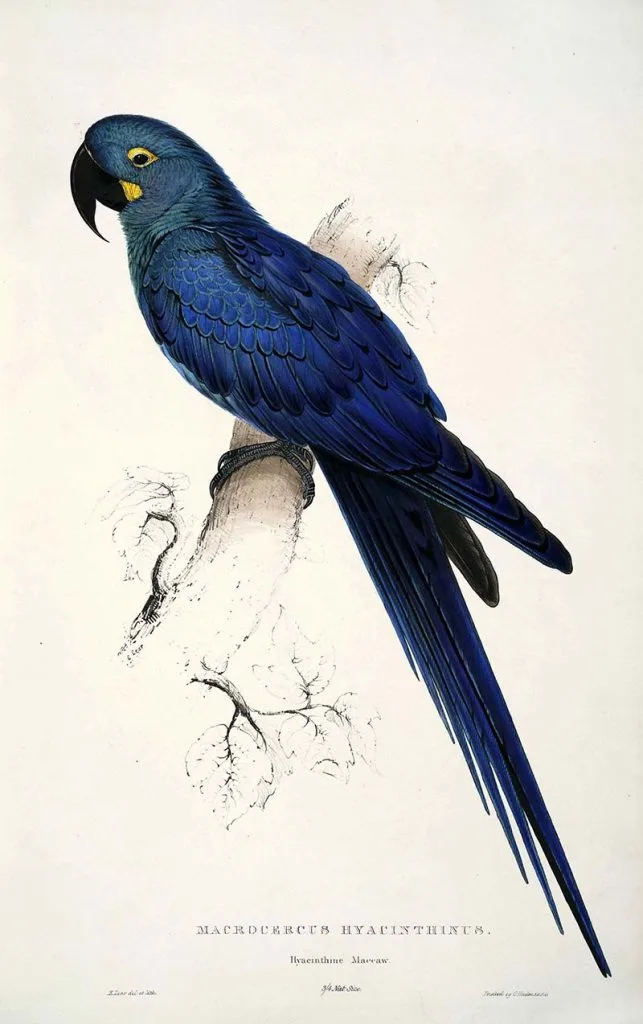
3. Uniform Parakeet – Platycercus unicolor
This parrot most likely got its name because it is just one colour; green. Parakeets are small to medium parrots with long tail feathers.

4. Dwarf Parakeet Macaw – Psittacara nana
Also known as the olive-throated parakeet. Due to the colour of the feathers on the bird’s throat. A native of Central America.
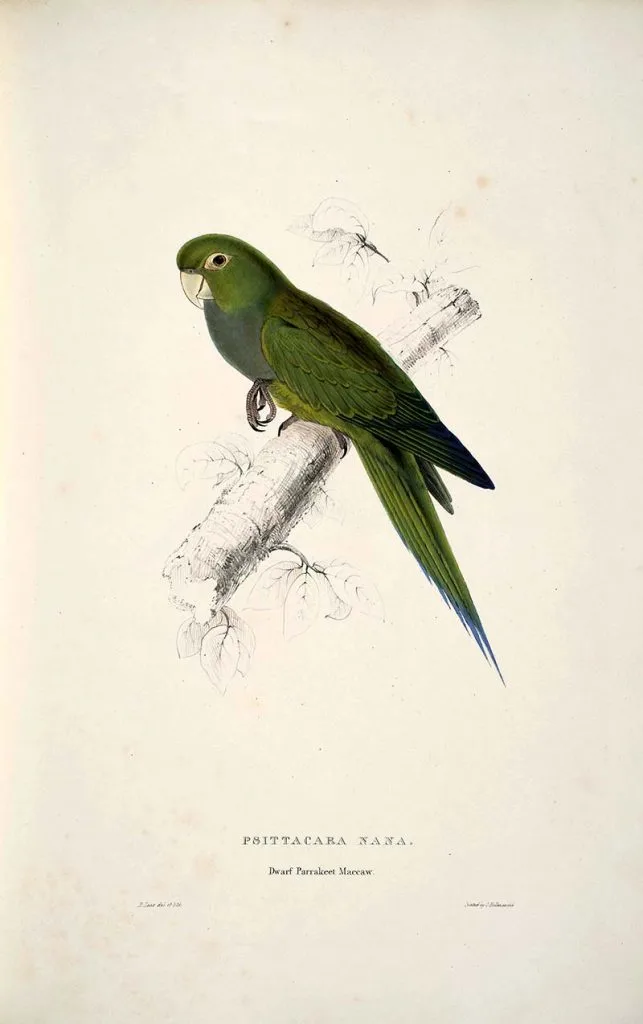
5. Patagonian Parakeet Macaw – Cyanoliseus patagonus
Not surprising this burrowing parrot is found mainly in Argentina. H
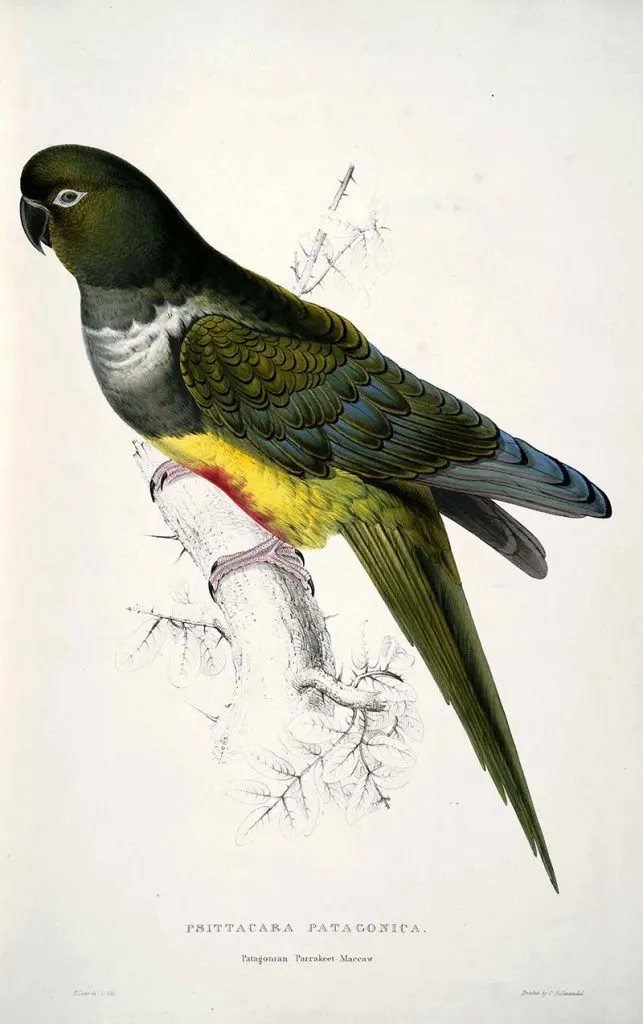
6. Blue and Yellow Macaw
This
When you say parrot to me, this is the one I imagine. I think it is a popular species of parrot used in film and TV.

7. Salmon Crested Cockatoo – Plyctolophus rosaceus
This is one of my
The Salmon-Crested Cockatoo is a very intelligent parrot. It has one of the loudest bird calls. Also, it’s a great mimic and is often featured in bird shows. However, most of the birds used for the shows have been bred in captivity. The trade of Salmon Crested Cockatoos is illegal in many countries.
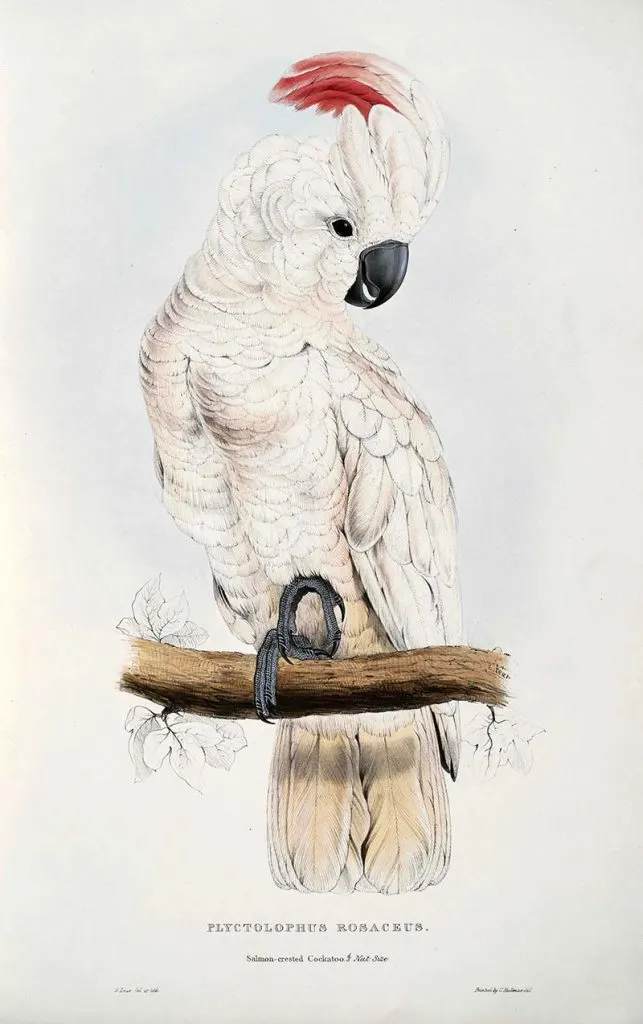
8. Red and Yellow Macaw – Ara Macao
The most
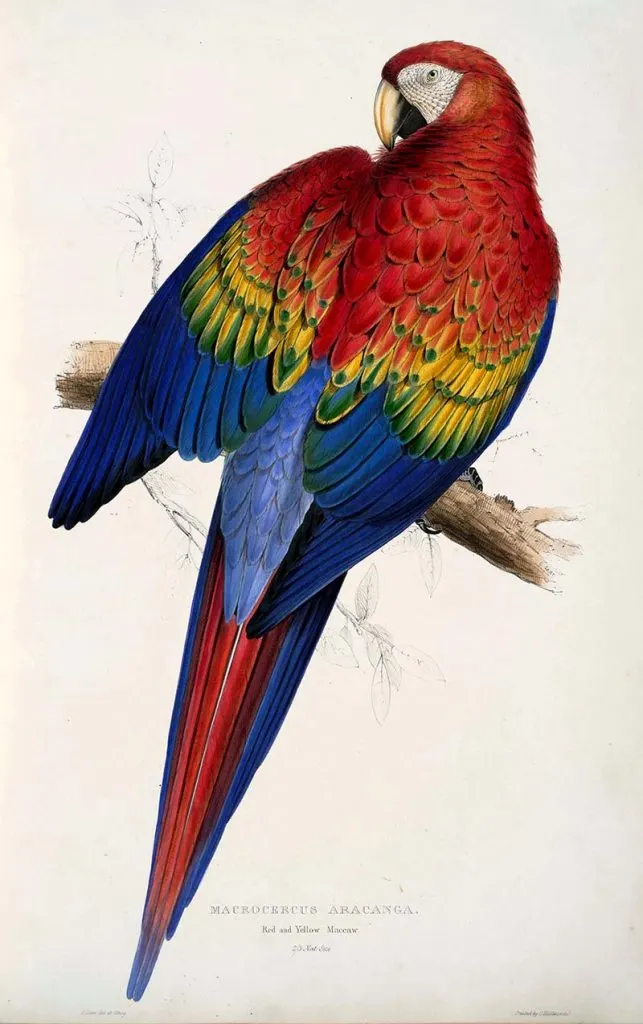
9. Stanley Parakeet – Platycercus icterotis
Also known as the Western Rosella, a native of southwestern Australia. Due to the possible damage, it could do to crops, the parrot was classed as a vermin until 1998. Then it was given “protective native species” status.
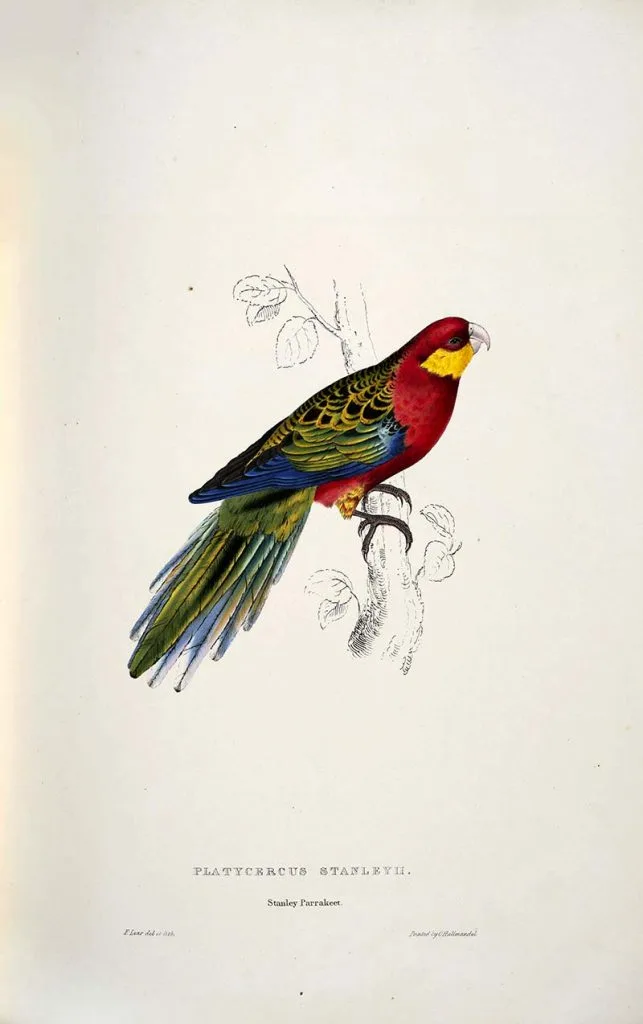
10. Black-Collard Lovebird
Lovebirds are a small family of parrots (9 species); they are among the smallest parrots. Lovebirds are characterized by a stocky build, a short blunt tail, and a relatively large, sharp beak.

11. Crimson Winged Parakeet (Male)
More commonly known as the red wing parrot due to the very distinctive red wings of both the male and female species.
The parrot is a native of Australia and mainly inhabits riverine forests, forest edges, mangroves, and farmlands. They are often seen in pairs or flocks near water.

12. Barnard’s Parakeet
More commonly known these days as the Australian ringneck parrot. Except for extreme tropical and highland areas, the species has adapted to all conditions and is only found in Australia.

13. Pair of Cockatiels
The cockatiel’s distinctive crest feathers on its head express the animal’s emotional state. The crest stands up when the cockatiel is startled or excited; it is gently oblique in its neutral or relaxed state and flattened close to the head when the animal is angry or defensive.
The crest is also held flat but protrudes outward in the back when the cockatiel is trying to appear alluring to the opposite sex. In contrast to most cockatoos, the cockatiel has long tail feathers roughly making up half its total length.

14. Pale-headed Rosella
The pale-headed rosella is a broad-tailed parrot native to northeastern Australia.
It is a moderate-size parrot with a pale yellow head, predominantly white cheeks, scalloped black and gold back and pale blue underparts.

15. Rose Ringed Parakeet – Yellow Variety
The rose-ringed parakeet is a medium-sized parrot.
It has disjunct native ranges in Africa and South Asia. It is now introduced into many other parts of the world where feral populations have established themselves and are bred for the exotic pet trade.

16. Variegated Parakeet
Now more commonly known as the Varied Lorikeet. The bird is found in eucalypt forests, wetlands and grassland areas in Northern Queensland, Northern Territory and Western Australia.

17. Guaiabero
The Guiaiabero is a parrot endemic to the Philippines and locally known as bubutok. Its common name is derived from its reputation for eating guavas.

18. Scaly-breasted Lorikeet
The common name of this Lorikeet aptly describes this bird, which has yellow breast feathers broadly edged with green that look like scales.

19. Red-capped Parrot
A beautiful Edward Lear parrot painting of the red-capped parrot. This distinctive bird is not easily confused with other parrot species.
That is because of its bright crimson crown, green-yellow cheeks, and distinctive long bill. The wings, back, and long tail are dark green, and the underparts are purple-blue.

20. Scarlet-collared Parakeet
Now known as the Red-collared Lorikeet.
The feathers of the head and throat are dark brown with blue shafts. There is an orange-red band on the back of the neck. The chest is orange with red. The base of the hindneck is dark blue. The wings are green. The bill is red. The legs and feet are grey-brown.

21. Leadbetters Cockatoo
This cockatoo is also known as Major Mitchell’s cockatoo. It is often thought of as one of the prettiest cockatoos, with its white and salmon-pink plumage and large, bright red and yellow crest.
It is named in honour of Major Sir Thomas Mitchell, who wrote, “Few birds more enliven the monotonous hues of the Australian forest than this beautiful species whose pink-colored wings and flowing crest might have embellished the air of a more voluptuous region.”
There is a painting of this cockatoo on these cigarette card illustrations of tropical birds.
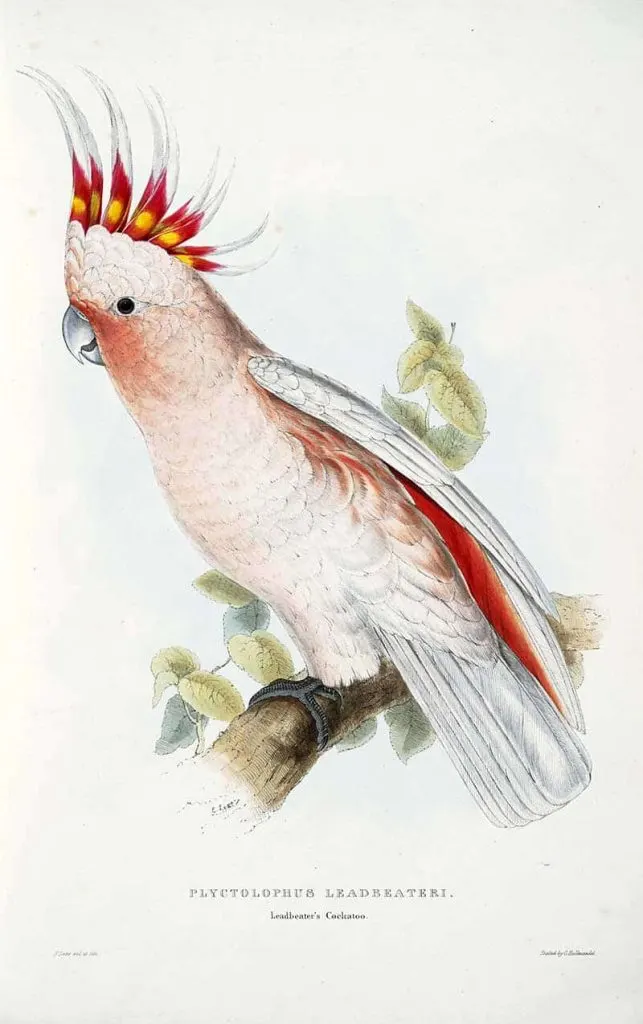
Other Related Posts
You’ll find an Edward Lear painting of boats in this vintage nautical image collection.
There are some gorgeous vintage sketches of parrots in Jan Brandes famous nature sketchbooks. And Ohara Koson painted red and blue parrots.
You will find an Edward Lear pelican painting here.
There is a painting of a North American parrot in the Mark Catesby print collection and a couple of parakeets with these printed wood slices.
If you liked these free vintage parrot paintings, check out some of my other free natural history illustrations, including these vintage bird nest drawings and an illustrated alphabet of birds.
- Exotic Birds of LeVaillant
- Natural History Posters of Adolphe Millot
- Free Toucan Paintings
- Beautiful Heron paintings
- Vintage hummingbird prints

If you fancy, you can Buy Me A Coffee Here.
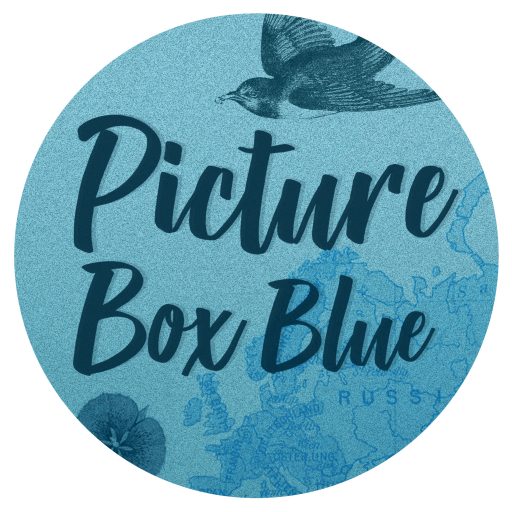
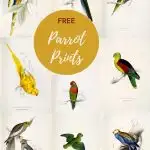
Harjith
Saturday 27th of April 2024
Beautiful ! Thank you for sharing
claire
Monday 29th of April 2024
Thank you, you're welcome.
Hui Nee
Thursday 10th of October 2019
hELLO! I love these vintage paintings! Just wondering if it's okay for me to use them as postcard prints? Thank you!
claire
Friday 11th of October 2019
Thank you, yes everything is copyright free so you n use them how you wish.
Joyce C.
Tuesday 18th of June 2019
I love all birds and these are wonderful. Thank you for sharing !
claire
Wednesday 19th of June 2019
Thank you, I'm glad you like them.
Julie Briones
Wednesday 27th of March 2019
These are gorgeous! I love birds and bird prints! Thanks for sharing at Homestyle Gathering!
claire
Wednesday 27th of March 2019
Thank you, me too. The cockatoos are my favourite.
Benita
Tuesday 26th of March 2019
These are absolutely gorgeous!!! Thank you so much for sharing at Celebrate Your Story! Have a great day!
claire
Tuesday 26th of March 2019
Thank you so much, I pleased you like them.